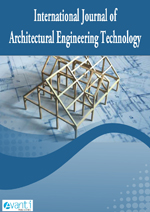Abstract
Commercial Computational Fluid Dynamics (CFD) software is practically applied in indoor environmental design recent years but the prediction accuracy of CFD simulation depends on the understanding for the fundamentals of fluid dynamics and the setting of appropriate boundary and numerical conditions as well. Additionally, deeper understanding to a specific problem regarding indoor environment is also requested. The series of this study aimed to provide with the practical information such as prediction accuracy and problematic areas related to CFD applications in indoor environment, air conditioning and ventilation, then performed benchmark tests and reported the results. In this Part 2, benchmark test results for cross-ventilation airflows and floor heating systems were introduced.
The highest reproducibility of the predicted results compared with the wind tunnel results occurred when the Z0-type wall function was used as the floor-surface boundary condition and the SST k–ω for the turbulence model in case of cross-ventilation flow and SST k–ω model showed also the closest matching results with experiment in case of natural convection in a room with floor heating.
References
Ito K, Inthavong K, Kurabuchi T, Ueda T, Endo T, Omori T, et al. Benchmark Tests Associated with Applying CFD to Indoor Environmental Problems: Part 1 Benchmark test for isothermal/non-isothermal flow in 2D and 3D room model. Int J Archit Eng Technol 2015; 2(1): 50-71.
Mochida A, Murakami S, Kondo K, Tsuchiya M. Numerical Study on Surface Pressures of Low-Rise Building Using Revised k-ε Model. Seisan-Kenkyu (in Japanese) 1996; 48: 55-59.
Murakami S, Mochida A. Numerical Prediction on the Plume Diffusion Around Building -Study on Buoyant Production Term in ε Equation. Seisan-Kenkyu (in Japanese) 1989; 41: 32-35.
Kurabuchi T, Ooba M, Iwabuchi T, Shimada T. Verification and Stream-tube Analysis of Simulated Result of Airflow of a Cross-ventilated Building for Normal Wind Angle Case: Analysis of airflow of cross-ventilated buildings based on LES and wind tunnel experiment (Part 1). J Archit Plann Environ Eng., Architectural Institute of Japan (in Japanese) 2002; 561: 47-52.
Ooba M, Kurabuchi T, Irie K. Experimental Study on Penetrating Flow and Pressure Loss Through Openings in a Cross-Ventilated Model Building. J Archit Plann Environ Eng., Architectural Institute of Japan (in Japanese) 2002; 552: 21-27.
Architectural Institute of Japan. Guidebook for Practical Applications of CFD to Pedestrian Wind Environment around Buildings. Architectural Institute of Japan (in Japanese) 2007.
Ono H, Sakai K, Kajiya R, Aoki R. Validation of Accuracy of CFD for Natural Convection Flow in Floor Heating Room: Part 1- Temperature Measurement of an Actual-Size Model, in Proceedings of SHASE (The Society of Heating, Air- Conditioning and Sanitary Engineers of Japan), (in Japanese) 2012; 178: 21-27.
Lien FS, et al. Low-Reynolds-Number Eddy-Viscosity modeling based on non-linear stress-strain/vorticity relations, Proceedings of.3rd Symposium on Engineering Turbulence Modelling and Measurements 1996; 1-10. http://dx.doi.org/10.1016/B978-0-444-82463-9.50015-0
Wilcox D. Turbulence Modeling for CFD. DCW Industries Inc, 5354 Palm Drive. La Canada, California 91011. 1993.
Menter Fr. Two-equation eddy-viscosity turbulence models for engineering applications. Am Int Aeronaut Asttronaut J 1994; 32: 1598-1605. http://dx.doi.org/10.2514/3.12149

This work is licensed under a Creative Commons Attribution-NonCommercial 4.0 International License.
Copyright (c) 2015 Kazuhide Ito; Kiao Inthavong, Takashi Kurabuchi, Toshikatsu Ueda, Tomoyuki Endo, Toshiaki Omori, Hiroki Ono, Shinsuke Kato, Koji Sakai, Yoshihide Suwa, Hiroshi Matsumoto, Hajime Yoshino, Weirong Zhang, Jiyuan Tu




